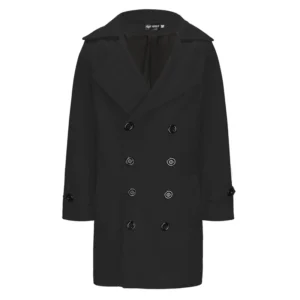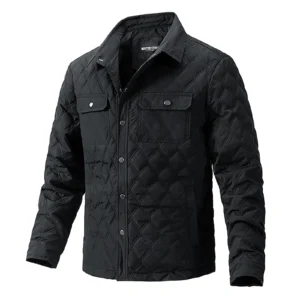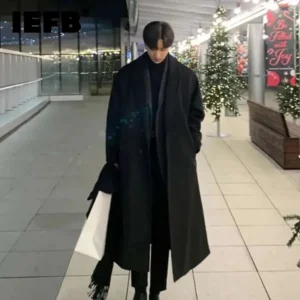Introduction: The Timeless Appeal of Double-Breasted Overcoats
The double-breasted overcoat stands as a pinnacle of men’s outerwear, defined by its overlapping front panels with two parallel columns of buttons creating a distinctive wrapped appearance. This elegant garment traces its lineage to military and naval uniforms of centuries past, where the extra fabric layers provided crucial protection against harsh elements at sea and on battlefields. Over time, this practical design evolved into a symbol of sophistication in civilian fashion.
What makes double-breasted overcoats truly special is their commanding silhouette. The overlapping front creates a V-shaped frame that broadens shoulders and narrows at the waist, lending the wearer an air of authority and refinement. This distinctive profile has allowed these coats to transcend fleeting fashion trends, enjoying particular prominence during the 1920s-30s golden age, resurging in the power-dressing 1980s, and finding renewed appreciation among today’s style-conscious men.
Icons of film and royalty have cemented the double-breasted overcoat’s cultural significance. From Humphrey Bogart’s trench coat to the British royal family’s tailored wool options, these garments have become visual shorthand for sophistication and good taste. Understanding the nuances of double-breasted coats for men helps appreciate why they’ve remained relevant despite fashion’s ever-changing landscape.
This guide aims to illuminate the variety of double-breasted overcoat styles available, helping you identify the perfect option for your needs while appreciating the subtle differences that make each variation unique. The differences between double and single-breasted styles extend far beyond button count—they represent entirely different approaches to elegance and function.
Understanding the Anatomy of a Double-Breasted Overcoat
Before exploring specific styles, it’s essential to understand the key components that distinguish one double-breasted overcoat from another. These fundamental elements not only affect the coat’s appearance but also its functionality and the statement it makes.
Lapel Styles
- Peak lapels: The traditional choice for double-breasted overcoats, pointing upward and outward for a formal, powerful appearance
- Notch lapels: Less common but more casual, featuring a visible notch where upper and lower lapel parts meet
- Lapel width: Varies from narrow (modern) to wide (traditional or vintage-inspired)
- Gorge line: The seam where lapel meets collar; higher placement creates a more contemporary look
Button Configurations
- 6×2 arrangement: Six buttons with only two functional (the standard formal configuration)
- 6×3 arrangement: Six buttons with three that fasten, creating a higher closure
- 4×2 arrangement: Four buttons with two functional, offering a cleaner, more modern aesthetic
- Button stance: Higher stance elongates the torso; lower stance can appear more relaxed
Front Closure Design
- Overlap depth: Deeper overlaps create more insulation and a more dramatic appearance
- Button spacing: Affects both style and function
- Fastening options: Some feature hidden buttons beneath the visible ones
Structural Elements
- Shoulder construction: Natural (less padding, more relaxed) vs. structured (padded, formal)
- Chest canvas: Floating vs. fused construction affecting drape and longevity
- Waist suppression: Degree of tapering at waist affecting the silhouette
Length Variations
- Full length: Typically falling below the knee for maximum protection
- Three-quarter length: Ending at mid-thigh, balancing protection with mobility
- Shorter variations: Like peacoats, ending at the hip for casual versatility
Back Details
- Center vent: Allowing ease of movement and a cleaner drape
- Side vents: Providing access to pockets and a more formal appearance
- Belted back: Feature on some styles adding waist definition and military flair
- Pleats: Enhancing movement capabilities while maintaining structure
Finding the right fit for your double-breasted coat is crucial, as these elements work together to create a cohesive garment. With an understanding of these components, you’re better equipped to evaluate the distinct styles offered in men’s double-breasted overcoats.
The Classic Paletot: Formal Elegance Personified
The Paletot represents the epitome of formal double-breasted overcoat styling. With French origins dating back to the 19th century aristocracy, this coat embodies refined elegance through clean, uncluttered lines and impeccable tailoring. Distinguished by its streamlined silhouette without extraneous details, the Paletot serves as the quintessential formal overcoat for business and ceremonial occasions.
Characteristic features of the classic Paletot include:
- A 6×2 button configuration, perfectly balanced and proportioned
- Elegant peak lapels that create a powerful chest frame
- Knee-length cut offering both warmth and formal presence
- Minimal ornamentation, emphasizing tailoring excellence
- Slightly suppressed waist creating a flattering silhouette
- Smooth, flat finishes without belts or decorative elements
The Paletot traditionally comes in luxurious fabrics that enhance its formal character. Fine merino wool, cashmere blends, and even pure cashmere from premium cashmere overcoat collections are ideal choices. Color selection typically remains conservative—navy blue, charcoal gray, and black dominate, reflecting the coat’s formal positioning.
For styling, the Paletot pairs perfectly with business and formal attire:
– Over business suits with conservative ties and polished oxfords
– With formal evening wear, including black tie ensembles
– Complemented by leather gloves and a formal scarf in coordinating tones
– Finished with a subtle pocket square for understated personality
The Paletot’s enduring appeal lies in its timeless simplicity and refusal to bow to passing trends. For the modern man seeking investment-worthy outerwear that will remain relevant through changing fashion cycles, the Paletot delivers unmatched sophistication and versatility within formal contexts.
The Robust Ulster: The Gentleman’s Weather Defender
Where the Paletot represents refined formality, the Ulster coat embodies rugged protection without sacrificing gentlemanly style. Born in the harsh weather of Northern Ireland (Ulster province), this substantive overcoat was designed for country gentlemen and travelers facing serious elements while maintaining proper appearance.
The Ulster’s distinctive features create an unmistakable profile:
- Fuller cut allowing room for heavy layers beneath
- Substantial convertible collar that can be turned up against wind and rain
- Optional cape or half-cape across shoulders for additional weather protection
- Belted back, often with inverted pleats for movement
- Deep flap pockets large enough for gloves and essential items
- Double-breasted front with larger, often decorative buttons
- Longer length typically falling below the knee
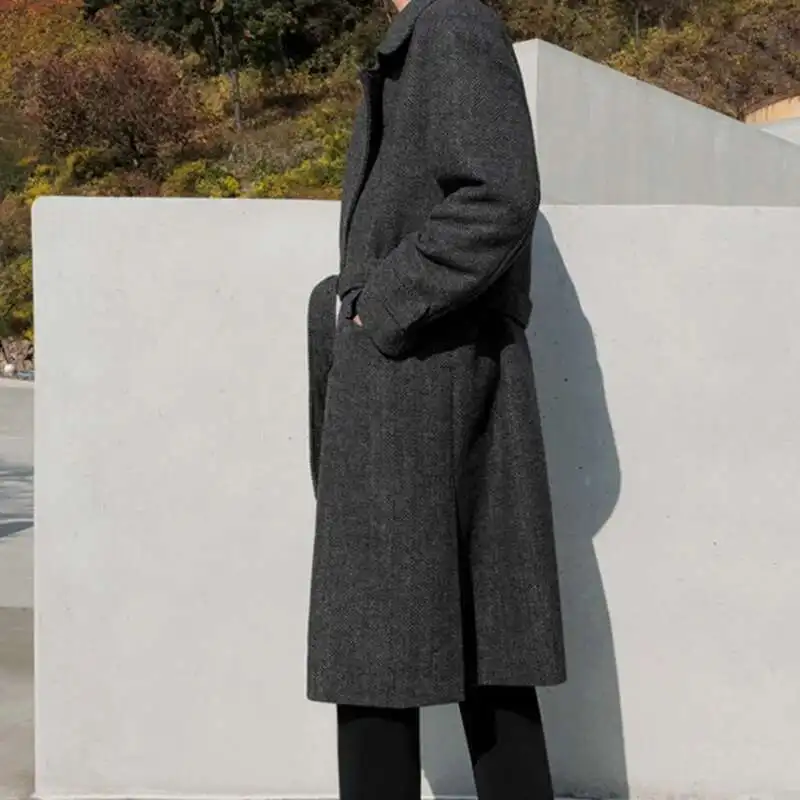
The Ulster demands substantial fabrics that stand up to the elements. Traditional tweed coats in herringbone or barleycorn patterns are classic choices, offering natural water resistance and insulation. Donegal tweed with its characteristic flecks adds visual interest, while heavy Melton wool provides maximum warmth. Colors tend toward earth tones—browns, greens, heathered grays—though navy remains a versatile option bridging country and city settings.
For styling the Ulster:
– Pair with rugged country attire: tweed suits, corduroy trousers, and sturdy boots
– In urban settings, contrast with sleek modern pieces for textural interest
– Add a cashmere scarf and leather gloves for additional protection
– Consider tweed caps or felt hats as complementary accessories
The Ulster’s appeal lies in its unapologetic robustness combined with thoughtful tailoring. It’s the perfect choice for those who refuse to compromise on style despite challenging weather, offering protection with character that only improves with age.
The Distinguished Guards Coat: Military Heritage Reimagined
The Guards coat carries the proud legacy of British military tradition into civilian wardrobes. Derived from the overcoats worn by elite British Guard regiments, this style balances formality with functional design elements that serve practical purposes while creating a commanding presence.
Distinctive features of the authentic Guards coat include:
- A 6×3 button configuration (sometimes 6×2) creating a higher closure point
- Structured shoulders providing a strong, military-inspired silhouette
- Center back vent with pleat allowing mobility while maintaining clean lines
- Optional half-belt at back recalling military uniform elements
- Slant or flap pockets positioned for both function and visual balance
- Turn-back cuffs on some variations, referencing historical uniform details
- Mid-calf to knee length providing substantial coverage
The Guards coat demands materials that communicate authority and resilience. Traditional wool overcoats in heavy cavalry twill or melton wool are authentic choices, with weights substantial enough to drape properly and provide genuine warmth. The color palette remains conservative—navy blue predominates, with black and charcoal as classic alternatives. This restraint in color emphasizes the coat’s authoritative presence.
For styling this military-inspired classic:
– Pair with formal business attire for a commanding professional presence
– Complement with leather gloves and a simple cashmere scarf
– Consider regimental ties that echo the coat’s military heritage
– Complete with polished oxford or derby shoes rather than casual footwear
The Guards coat appeals to those who appreciate its blend of history and authority. Its structured silhouette flatters most body types, creating a powerful impression while honoring its origins in military precision and function.
The Refined Polo Coat: Sporting Elegance
The Polo coat occupies a unique position in the double-breasted overcoat family, having evolved from purely functional sporting origins into a symbol of casual sophistication. Originally worn by polo players between chukkers for warmth, this style gradually transitioned from the playing fields to become a favorite among style-conscious gentlemen seeking a less formal but equally distinguished option.
Characteristic elements of the classic Polo coat include:
- Full belt at the waist, cinching the silhouette
- Typically a 6×2 button configuration, though variations exist
- Patch pockets with flaps, emphasizing the casual sporting heritage
- Set-in sleeves with natural shoulders rather than structured padding
- Three-quarter length ending around mid-thigh
- Turn-back cuffs on traditional versions
- Often features a half-back belt in addition to the full belt
The Polo coat is traditionally crafted from camel hair, giving it both its distinctive color and reputation for lightweight warmth. Modern interpretations may use camel-colored wool or wool-cashmere blends that maintain the look while offering various weight and price options. While camel is the signature color, navy and tan versions offer alternatives while maintaining the coat’s casual sophistication.
When styling a double-breasted coat like the Polo, versatility becomes its greatest virtue:
– Pair with business casual attire: flannel trousers and sweaters
– Dress down with dark denim and a turtleneck for weekend elegance
– Combine with loafers or suede chukka boots rather than formal shoes
– Add a colorful scarf to complement the warm tones of traditional camel hair
The Polo coat appeals to those seeking outerwear that bridges formal and casual contexts effortlessly. Its belted waist flatters most body types, while its sporting heritage provides a conversation piece for the style-conscious gentleman.
The Nautical Peacoat: Maritime Heritage for Modern Wear
The Peacoat stands apart as the most casual and compact member of the double-breasted overcoat family. With direct lineage from naval uniforms, this shorter style was designed for sailors who needed freedom of movement combined with protection against harsh sea winds and spray. Today, it represents the perfect entry point into double-breasted styling for the casual dresser.
Key features defining the authentic Peacoat include:
- Shorter length typically ending at hip or just below
- Broader lapels that can be fully turned up as collar protection
- Vertical or slant hand warmer pockets
- Shoulder straps (epaulettes) on some traditional versions
- Dense, heavy fabric providing substantial warmth despite shorter length
- Slightly less formal 4×2 or 6×3 button configuration
- Straight cut rather than suppressed waist
The Peacoat demands dense, heavyweight fabrics to fulfill its protective function. Traditional versions use Melton wool in 24-32 oz weight ranges, creating the substantial feel that defines authentic double-breasted pea coats. The color palette remains simple and practical—navy blue dominates as the authentic choice, with black offering a slightly more urban interpretation.
For styling this nautical classic:
– Pair with casual pieces like jeans and chunky sweaters
– Combine with boots or casual leather sneakers
– Add a simple wool scarf in complementary colors
– Keep accessories minimal to honor the coat’s utilitarian origins
The Peacoat’s enduring appeal lies in its accessible style and genuine functionality. For those seeking double-breasted elegance in a casual context, or as an entry point into this coat category, the Peacoat delivers authentic heritage without overwhelming formality.
The Versatile Double-Breasted Trench: Weather-Ready Sophistication
The double-breasted trench coat represents perhaps the most versatile option in the spectrum of double-breasted outerwear. Developed originally for British military officers in World War I, this coat combines practical water resistance with distinctive style elements that have made it a civilian classic. Its ability to bridge formal and casual contexts makes it an essential piece for varied wardrobes.
Distinctive features of the authentic double-breasted trench include:
- Military-inspired epaulettes on shoulders
- Storm flap across right shoulder and chest
- Full belt with distinctive D-ring buckle
- Wrist straps allowing adjustable cuff closure
- Throat latch for additional weather protection
- Deep vents or cape effect at back for movement
- Typically falls to just below knee length
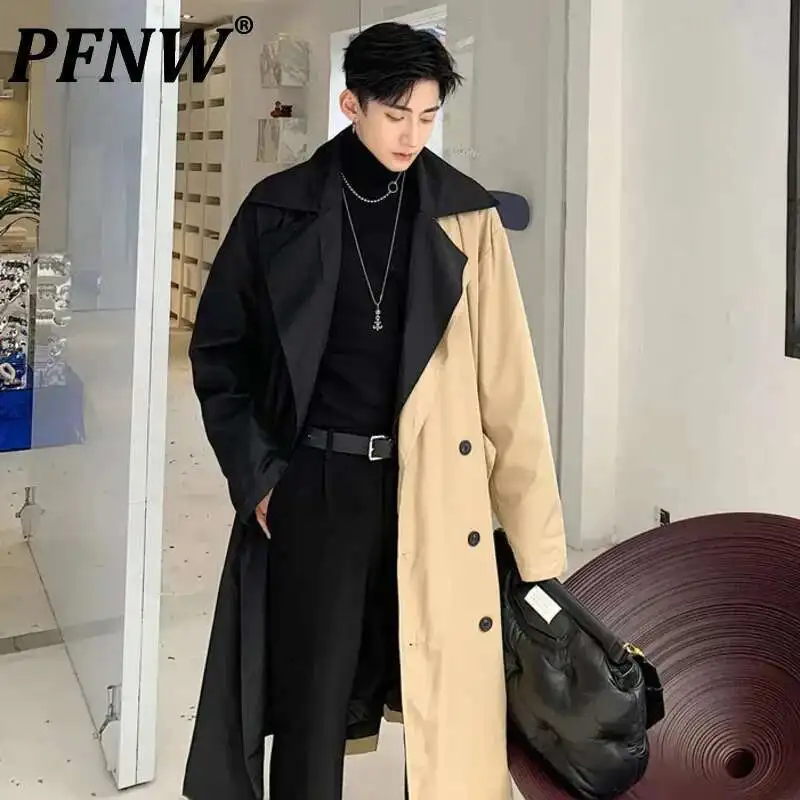
Traditional trench coats utilize water-resistant cotton gabardine, though modern interpretations might incorporate technical fabrics or wool blends for additional insulation. The classic color palette remains focused on practical neutrals—khaki and beige dominate as heritage choices, with navy and black offering more urban alternatives.
For styling this adaptable classic:
– In business contexts, wear over suits with the belt tied properly
– For casual wear, layer over jeans and sweaters with belt loosely knotted
– During transitional seasons, adjust layering beneath rather than changing coats
– Consider the collar position—turned up for drama and weather protection or folded down for formality
The trench coat’s appeal lies in its chameleon-like ability to adapt to different settings while maintaining its distinctive character. Its belted waist flatters most body types, while its rich history provides subtle military flair without overwhelming the wearer. Those seeking maximum versatility from their investment in men’s cashmere overcoat styles often find the trench coat’s adaptability unmatched.
The Formal Chesterfield: Double-Breasted Refinement
The double-breasted Chesterfield represents a perfect marriage of traditional formality and subtle sophistication. While the Chesterfield style exists in both single and double-breasted variations, the double-breasted version offers enhanced warmth and visual impact. With origins in 19th century aristocratic dress, this coat carries an air of refined prestige while maintaining practical functionality.
Defining features of the double-breasted Chesterfield include:
- Clean, minimalist lines without belt or back details
- Optional velvet collar in contrasting color (typically black)
- Concealed placket on some variations for a smoother appearance
- Flap pockets positioned at hip level
- 6×2 button configuration in traditional versions
- Moderate structure in shoulders without excessive padding
- Mid-thigh to knee length for proper formal proportion
The Chesterfield demands refined fabrics that communicate quality without flashiness. Fine woolen fabrics in herringbone or bird’s eye patterns offer subtle texture, while cashmere blends provide luxurious softness and warmth. The color palette remains conservative—charcoal gray and black overcoats dominate, with navy as a slightly less formal alternative.
For styling this refined classic:
– Pair with formal business attire including suits and ties
– Consider for evening events over cocktail attire
– Complement with leather gloves and a simple, elegant scarf
– Finish with a subtle pocket square for additional refinement
The Chesterfield’s appeal lies in its understated elegance and versatility across formal contexts. It flatters most body types while maintaining a clean silhouette, making it the perfect choice for those seeking refined outerwear without flashy details or trend-driven styling.
Selecting Your Ideal Double-Breasted Overcoat
Choosing the perfect double-breasted overcoat requires consideration of several factors beyond mere aesthetics. The right coat should complement your body type, suit your climate needs, integrate with your existing wardrobe, and fulfill your specific occasion requirements.
Body Type Considerations
- Taller, leaner builds: Most styles work well; consider longer lengths like the Paletot or Ulster for balanced proportion
- Shorter frames: Choose shorter styles like the Peacoat or mid-thigh Guards coat; avoid overwhelming volume
- Broader builds: Guards coats with structured shoulders create balance; consider moderate waist suppression
- Slimmer builds: Polo coats with belted waists add structure; Ulster coats add beneficial volume
Climate and Functionality
- Severe winters: Ulster or Guards coats in heavyweight wool offer maximum protection
- Moderate climates: Chesterfield or Paletot in medium-weight wool provide versatility
- Rainy regions: Double-breasted trench coat with water-resistant properties
- Transitional seasons: Lighter weight Polo coat or shorter Peacoat options
Wardrobe Compatibility
- Formal business wardrobe: Paletot or Chesterfield coordinate seamlessly with suits
- Business casual dominance: Polo coat offers appropriate versatility
- Casual lifestyle: Peacoat integrates with jeans and casual pieces
- Varied wardrobe: Trench coat adapts across multiple dress codes
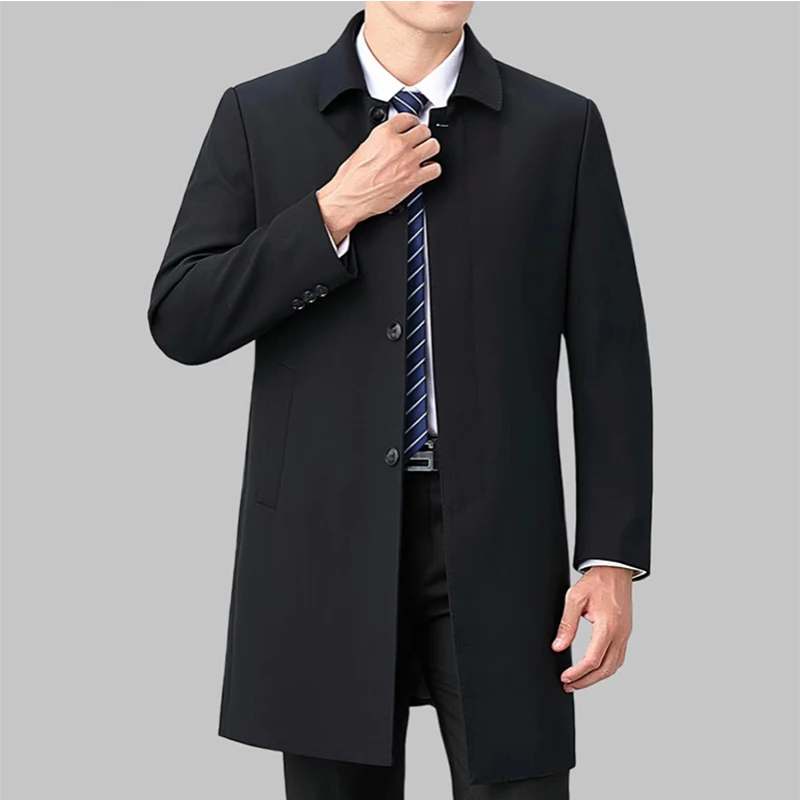
Occasion Appropriateness
- Formal business settings: Paletot or Chesterfield maintain professional appearance
- Outdoor events: Ulster provides weather protection with style
- Weekend casual: Peacoat offers relaxed yet pulled-together appearance
- Versatile needs: Trench coat transitions effectively between settings
Investment Value
- Timeless appeal: Paletot and Chesterfield rarely deviate from classic proportions
- Trend resistance: Guards coat maintains consistent styling over decades
- Heritage value: Ulster and Polo coats connect to rich style traditions
- Versatile return: Trench coat serves multiple purposes across seasons
Understanding the advantages of double-breasted coats helps inform this important decision. When selecting your ideal style, prioritize versatility within your most common contexts, ensuring maximum wear value from your investment.
Mens Double Breasted Pea Coat, Mens Wool Blend Coat, Mens Wool Pea Coat
Price range: $136.84 through $157.36 Select options This product has multiple variants. The options may be chosen on the product pageMens Cashmere Overcoat, Mens Hooded Winter Coat, Mens Wool Blend Coat
Price range: $128.72 through $139.68 Select options This product has multiple variants. The options may be chosen on the product pageMens Black Overcoat, Mens Black Wool Coat, Mens Wool Overcoat
$339.18 Select options This product has multiple variants. The options may be chosen on the product pageMens Double Breasted Pea Coat, Mens Hooded Winter Coat, Mens Quilted Coat
Price range: $81.00 through $108.48 Select options This product has multiple variants. The options may be chosen on the product pageMens Grey Overcoat, Mens Wool Blend Coat, Mens Wool Overcoat
$201.28 Select options This product has multiple variants. The options may be chosen on the product pageMens Herringbone Coat, Mens Long Overcoat, Mens Wool Overcoat
Price range: $197.16 through $203.69 Select options This product has multiple variants. The options may be chosen on the product page
Premium Fabrics: The Foundation of Exceptional Overcoats
The fabric selection for your double-breasted overcoat significantly influences its appearance, performance, and longevity. Understanding fabric characteristics helps ensure your coat meets your specific needs while providing the desired aesthetic impact.
| Fabric Type | Characteristics | Best For | Typical Styles |
|---|---|---|---|
| Melton Wool | Dense, weather-resistant, structured | Cold climates, formal settings | Paletot, Guards Coat |
| Cashmere | Lightweight, soft, luxurious | Milder winters, formal occasions | Paletot, Chesterfield |
| Tweed | Textured, durable, moisture-resistant | Country wear, casual settings | Ulster, Polo Coat |
| Camel Hair | Distinctive color, soft, insulating | Statement pieces, versatile wear | Polo Coat |
| Gabardine | Tightly woven, water-resistant | Rainy conditions, transitional seasons | Trench Coat |
| Wool-Synthetic Blends | Improved durability, easier care | Everyday wear, budget options | Peacoat, modern adaptations |
Melton wool, typically weighing 20-32 oz/yd², provides exceptional structure and wind resistance, making it ideal for formal coats requiring crisp lines. Cashmere, while lighter at 14-18 oz/yd², offers superior insulation despite its reduced weight, creating luxurious coats that remain practical in mild to moderate winter conditions.
Tweed variants like herringbone, barleycorn, and Donegal offer natural water resistance through their tight weave and lanolin content. Their typical weight of 16-24 oz/yd² balances warmth with wearability, while their textured appearance creates visual interest appropriate for country-inspired styles like the Ulster.
Camel hair, beyond its distinctive color, provides excellent insulation at a remarkably light weight (14-18 oz/yd²). Its natural hollow fiber structure traps air efficiently, creating warmth without bulk—perfect for the elegant Polo coat.
When selecting fabrics, consider not just aesthetics but practical performance. Heavier fabrics generally offer better wind resistance and drape more impressively, while lighter options provide greater comfort during active movement. The best colors for herringbone coats and other fabric patterns can significantly influence your coat’s versatility across different settings.
Styling Mastery: Wearing Your Double-Breasted Overcoat with Confidence
A double-breasted overcoat represents a style statement regardless of specific design. Wearing these distinguished garments effectively requires thoughtful coordination with underlying clothing and accessories to create cohesive, confident looks across various settings.
Formal Business Attire
- Pair Paletot or Chesterfield styles with tailored suits in complementary colors
- Ensure coat length extends beyond suit jacket by 2-4 inches
- Choose conservative ties and pocket squares that coordinate without matching exactly
- Complete with polished oxford shoes and minimal jewelry
- Consider dark leather gloves and a simple cashmere scarf in harmonious tones
Smart-Casual Integration
- Combine Guards coat or Polo coat with separates (sport coat and trousers)
- Layer over merino or cashmere knitwear with open-collar shirts
- Add textural interest with patterned scarves in complementary colors
- Complete with derby shoes or refined boots in quality leather
- Consider leather or suede gloves in rich browns or burgundy
Weekend Casual
- Use Peacoat or shorter double-breasted styles with premium denim
- Layer over crew neck or turtleneck sweaters for classic casual elegance
- Add textural contrast with knitted scarves and casual hats
- Complete with casual boots or refined sneakers depending on desired formality
- Consider more expressive accessories to personalize the look
Layering Strategies
- In severe cold: Add lightweight merino base layers beneath standard clothing
- For transitional seasons: Choose lighter weight shirts and knitwear beneath substantial coats
- When traveling: Select versatile midweight pieces that adapt to temperature changes
- For added warmth: Consider vests or lightweight gilets beneath longer coat styles
Accessorizing
- Scarves: Choose textures and patterns that complement coat fabric while adding visual interest
- Gloves: Match leather quality to overall formality; consider color coordination with shoes
- Hats: Select styles appropriate to coat formality (fedoras with formal coats, casual caps with Peacoats)
- Bags: Ensure leather goods coordinate with other leather accessories for cohesive appearance
Understanding how to create classic double-breasted coat combinations allows you to maximize your coat’s versatility while maintaining authentic style. The key lies in respecting the formality level of your chosen coat style while finding creative ways to express personal taste through thoughtful coordination.
Expert Care: Maintaining Your Double-Breasted Overcoat’s Excellence
A quality double-breasted overcoat represents a significant investment that can provide decades of service when properly maintained. Implementing regular care routines protects this investment while ensuring your coat continues to make a positive impression.
Essential care practices include:
- Daily maintenance:
- Brush coat with a quality garment brush after each wearing
- Allow 24 hours rest between wearings on a proper wooden hanger
- Spot clean minor marks promptly with appropriate cleaning products
Address moisture exposure by allowing thorough drying before storage
Professional care:
- Dry clean only when necessary (typically once per season)
- Select cleaners experienced with premium outerwear
- Discuss fabric-specific concerns with your cleaner
Consider professional pressing to restore structured elements
Seasonal storage:
- Clean coat thoroughly before extended storage
- Use breathable garment bags rather than plastic
- Store with cedar blocks or lavender sachets as natural moth deterrents
- Avoid compressed storage that may damage structure
Select cool, dry storage locations away from direct sunlight
Preventative measures:
- Apply fabric protector to non-formal coats exposed to harsh conditions
- Rotate coats when possible to extend lifespan
- Address minor damage (loose buttons, small tears) immediately
Reinforce stress points before failure occurs
Restoration considerations:
- Budget for occasional reweaving or elbow patch addition after years of wear
- Consider professional remodeling for vintage pieces with outdated proportions
- Maintain or replace buttons as needed to preserve appearance
With proper care, a quality double-breasted overcoat becomes more than a seasonal purchase—it transforms into a personal legacy piece that improves with age while providing exceptional service through countless winters.
Why Double-Breasted Overcoats Remain Unmatched in Men’s Outerwear
Double-breasted overcoats continue to represent the pinnacle of men’s outerwear due to their unmatched combination of practical function and timeless elegance. Their overlapping front construction provides superior insulation against harsh elements, while their distinctive silhouette creates an impression of authority and refinement impossible to achieve with other garment styles.
Unlike trend-driven pieces that quickly become dated, these classic coats transcend fashion cycles. A well-chosen double-breasted overcoat purchased today will remain relevant and stylish for decades, making it not merely an expense but a true wardrobe investment. The variety of styles within this category ensures options appropriate for every context, from the boardroom to weekend getaways.
Perhaps most importantly, double-breasted overcoats possess a unique ability to elevate any outfit they accompany. Even simple attire gains distinction when topped with these commanding garments, making them essential tools for men who understand that lasting style transcends passing trends. For those seeking outerwear that combines heritage, functionality, and uncompromising elegance, the double-breasted overcoat remains the definitive choice for mastering formal double-breasted coat style.
Frequently Asked Questions About Double-Breasted Overcoats
Are double-breasted overcoats always more formal than single-breasted ones?
While generally perceived as more formal, the formality level depends on specific style. A casual double-breasted peacoat may be less formal than a structured single-breasted Chesterfield. However, when comparing identical styles, the double-breasted version typically projects greater formality and traditional elegance.
What’s the ideal length for a double-breasted overcoat?
The ideal length depends on intended use and personal proportion. Formal coats traditionally fall to the knee, providing proper coverage over suits. Shorter styles ending at mid-thigh offer greater mobility for casual wear. For most men, a coat that ends just above the knee provides optimal versatility across situations while ensuring proper protection.
Can shorter men wear double-breasted overcoats successfully?
Absolutely. Shorter men should consider coats with higher button stance, moderate lapel width, and length ending mid-thigh rather than at the knee. Avoiding overwhelming volume and excessive details helps maintain proper proportion. The Peacoat and shorter Guards coat variations often work particularly well for men under 5‘8”.
How should a double-breasted overcoat fit when fully buttoned?
A properly fitted double-breasted overcoat should close comfortably without strain across chest and shoulders when fully buttoned. You should be able to insert a flat hand between your chest and the buttoned coat. The shoulder seams should align with your natural shoulders, and sleeve length should allow ½-inch of shirt cuff to show. When closed, the lapels should lie flat against the chest without gaping.
Are double-breasted overcoats warmer than single-breasted styles?
Yes, generally. The overlapping front panels create an additional layer of fabric across the chest and torso, providing superior insulation against wind and cold. This inherent design advantage makes double-breasted coats particularly effective for harsh winter conditions, explaining their origins in military and naval contexts where protection from elements was paramount.


